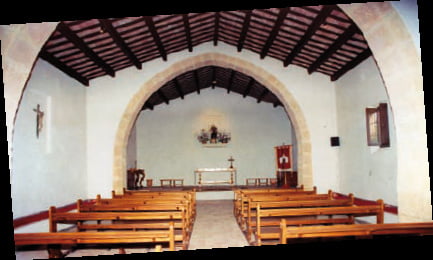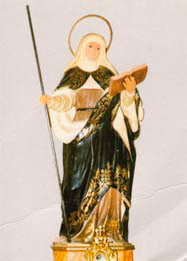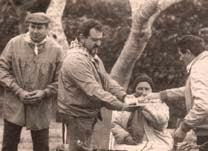Some Christian and immersed in the countryside, on the border with forests, silvas and then some in desert areas, villas rise during the fourteenth and fifteenth centuries, hermitages have some similar features in their architecture. They are UNINAVE buildings, with side or not, covered wooden frame and roof to double slope chapels. flat head.
The roof is supported by diaphragm arches or targeted. Their presence is observed throughout the Valencian area.
The chapel of Santa Paula de Dénia is an exceptional testimony. It sits on the ruins of a farmhouse or late Andalusian rafal and rises as part of a complex building or monastery. We have documentation that specifies the causes of its erection and its chronology.

It is a rectangular building, UNINAVE with three separated by two diaphragm sections slightly pointed arches. flat head. Diaphragm bows are constructed with blocks of local sandstone and start from the floor and from interior buttresses. In the works prior to the restoration documentation Open Access portal it was found on the northern wall in the first leg, no doubt belonging to the founding moment of the building. Currently accessed by the west. This lateral access would undoubtedly have some connection with the circulation and connection to the building complex of the monastery, which should have other units north of the nave of the chapel. The cover, gabled, would be supported by beams between arcs and on cantilevers or stone dogs.
Some aspects of the life and activity of Sister Caterina Bas, ISOR Basotaî, and momentum in the construction of the hermitage of Sant Antoni (Xàbia) In lands of the convent of Sant Jeroni, Les Plans Xàbia, it is reflected in historiography since the seventeenth century.
Two documents 1404 credited the reason for the founding of Santa Paula, who called ìsglesiaî, or ìmonestirî and its construction with Caterina Bas as the main character in the game of Real.
Text: Josep A. Gisbert Santonja, published in "Annuaris Culturals. Monuments. 2008. "
FEAST OF SANTA PAULA, 26 JANUARY
Party lawyer of skin diseases, especially scabies, is celebrated in the chapel
rural from medieval times. At the same it joins a 'porrat "deep roots and traditions in Valencian.
The festero starts at dawn with the arrival of the porrateros and assembly of their stops, giving a market environment commemoration. About nine o'clock the doors of the chapel open to pilgrims and devotees make offerings to the holy candles and make their supplications and prayers, after visiting the
different stops of the "porrat". Throughout the morning the incessant sounding of the bell of the hermitage warns the neighbors of the departure of the day of the feast.
At noon Mass at the end of which it is held solemn and after the singing of the joys Santa Paula, donuts, Coca Mary and mistela spread. The pilgrims attending the party behind these acts come to holding a picnic with food they have brought. Afternoon visits continue "porrat" and the chapel, seeking the protection of the saint. The festival ends at sunset with
the song of the joys, the retreat of the "porrat" and the visit of the associates to the Residencia de Ancianos, where they deliver donuts and coca maría to the residents there.
Text extracted from the "Multidisciplinary Study of the Natural Park Montgó (Alicante) ”.
VV.AA.









